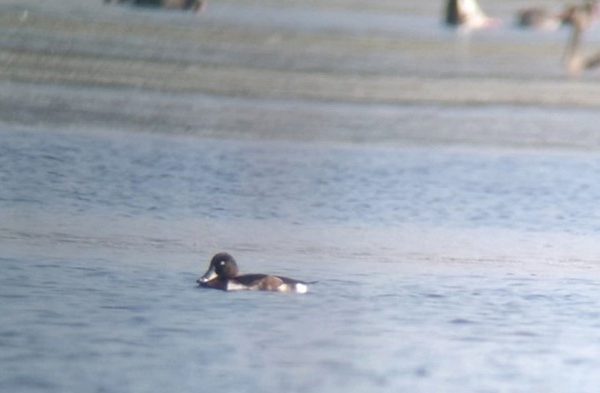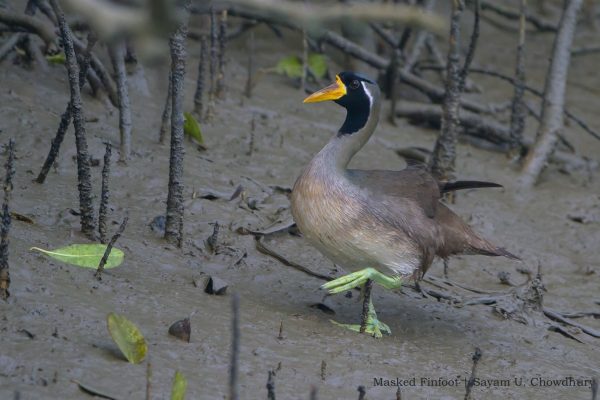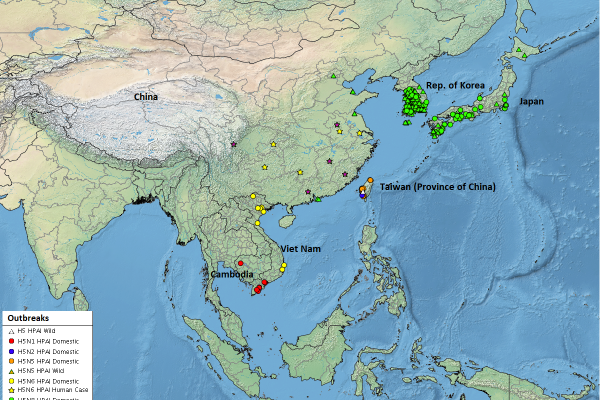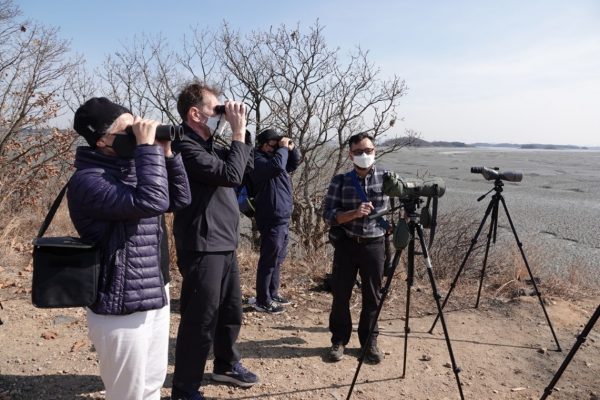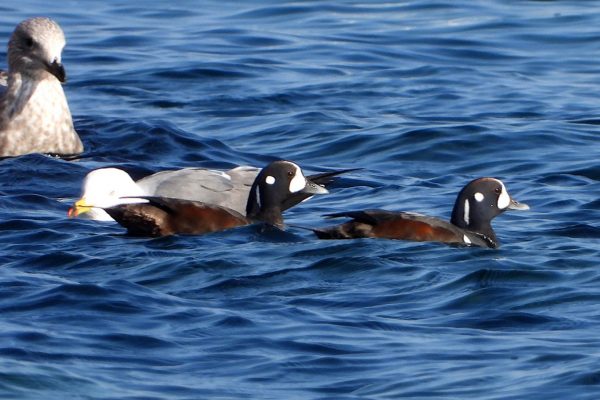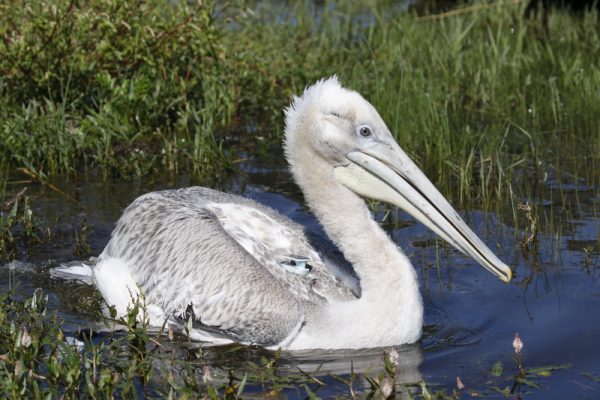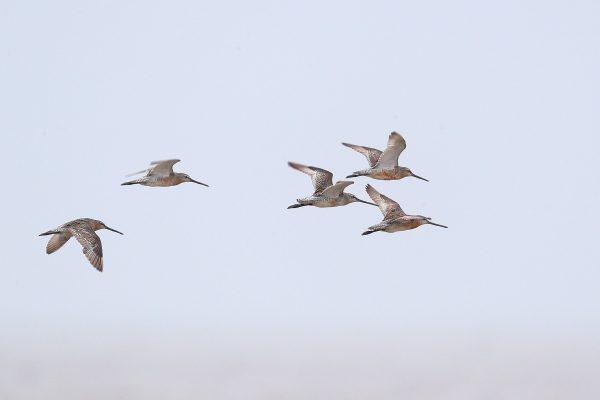-
Research to conserve Baer’s Pochard in Pyu Lake and Paleik Inn, central Myanmar
Data of population and distribution of Critically Endangered Baer’s Pochard was collected during various trips to Pyu Lake, Paleik Inn and Banaw freshwater lakes comprising four years of fieldwork…
Continue reading -
The iconic Masked Finfoot of Indo-Burma’s forested wetlands is on the brink of extinction
Few species of waterbirds in the Indo-Burma region are as threatened as the highly distinct Masked Finfoot (ranked 43 on the EDGE species list), currently listed as ‘Endangered’ on…
Continue reading -
Updates of worldwide avian influenza situation by FAO/EMPRES-AH (Dec-Feb 2021)
FAO/EMPRES-AH is constantly monitoring the avian influenza situation worldwide and compiles information from multiple national and international sources as well as peer-reviewed scientific articles. Close collaboration with country and…
Continue reading -
Red-crowned Crane Birdwatching Event at Ganghwa Island, Ro Korea with GCF and Irang
On 27 February, the EAAFP Secretariat and 5 staff of Green Climate Fund (GCF) participated in the Red-crowned Crane Birdwatching event organized by Eco Edu hub Irang which is…
Continue reading -
“Flyway: connecting people and migratory waterbirds” story series #9 – Interview with Ms. Serang Chung, writer in Ro Korea
Writer Serang Chung, “I like the fact that birdwatching is based on respect between birds and human” Writer…
Continue reading -
Seabird Survey in Goseong, Ro Korea
On 9 February 2021, Mr. Doug Watkins, Chief Executive, Ms. Vivian Fu, Communication Officer, and…
Continue reading -
First GPS tracking study of the Dalmatian Pelican in East Asia
After several years of careful planning, Mongolian biologists captured and color-banded 13 juvenile Dalmatian Pelicans at Khar Us Lake National Park (Flyway Network Site EAAF 128) in August 2020. Because the population situation is too fragile due to its extremely low number, we sought various advice about the methods and tools that can be used to capture and mark them. We invited experts from Greece and Russia with field experiences in handling and marking pelicans and asked for practical advice before we lay hands on pelicans. Juvenile Dalmatian Pelicans © Nyambayar Batbayar/ WSCC of Mongolia In addition to alphanumeric yellow color bands, which were donated by Society for the Protection of Prespa (SPP). We deployed two GSM GPS transmitters as backpack on the two biggest juveniles. Those two transmitters were donated by BirdsData, a Chinese GPS transmitter manufacturer. We were all excited. Thankfully the transmitters are working well to date despite having some difficulties to transmit the data on regular basis in the wintering area because of the frequent condition of having thick clouds. Migration of the first juvenile pelican started on 25th September and arrived at its final destination in Wenzhou Bay in East China on 8th January, after travelling over 4,200 km distance in 105 days. The second juvenile started its migration on 2nd October and arrived at the same place on 8th December after travelling over 3,800 km in 62 days. They used similar routes and made 14-15 stops during this migration. Both birds flew between stopovers on an average 5-9 hours from the morning till the evening until they reach a night roost. It seems their successful migration highly depends on available night time roosts during this long journey. We were astonished by seeing both birds have roosted on open steppe area in the middle of Gobi desert, most likely an area without open water. One of these dry roosts was even located in the middle of a busy road. High precision GPS tracks of one bird showed that it walked about 17 km after it landed on an open area and changed its locations three times on that night. It must have been hard for the pelicans to spend the night on such dry roosts. Fortunately, both birds spent the nights safely and continued their migration next day without any incident. Migration route of two juvenile Dalmatian Pelican with GSM GPS transmitters © Nyambayar Batbayar/ WSCC of Mongolia Compared to populations in other parts of the range, Dalmatian pelicans in East Asia make the longest migration. The tracking data showed that the two tagged pelicans made regular daily stops when flying through Mongolia until they reached their first stopover site in China. We were relieved when birds safely arrived at Yellow River in Inner Mongolia, because it is the largest open water where the pelicans rested since they left Orog and Boontsagaan Lake in Mongolia, which is over 1,000 km distance. Once birds reached China, the number of wetlands where they can rest seems to be more abundant. However, the birds also seem to be quite picky when choosing stopover sites. At the moment, we are not completely sure what makes them choose one site over another. We will need more tracking data to draw some meaningful conclusions about their stopover site selection. Two pelicans stopped at several locations along the east coast of China such as Beidagang Reservoir, Yellow River Delta, Haizhou Bay, Zhonglu Harbor, Daiyugang outflow, Yangze River, Hangzhou Bay, Taizhou Bay, and Wenzhou Bay. They all seem to be extremely important for Dalmatian Pelicans to successfully continue their migration. It is crucial to ensure the connectivity of these sites to sustain their migration. Since the two tagged pelicans arrived in China, birdwatchers and conservationists in China are helping us to report the location and number of pelicans. We appreciate their help very much, because they are making really important contributions for the conservation of the pelican. The sharing of inforamtion help the researchers to understand more about the species and the causes of their decline. The latest report from the Wenzhou Bay came 2 days ago saying the pelicans might have started heading back to the north. This migration study was a part of the joint conservation efforts by the East Asia-Australasian Flyway Partnership’s Dalmatian Pelican Task Force. The goal of the Dalmatian Pelican Task Force is to restore the East Asian population of Dalmatian Pelican to a positive growth rate for a period of at least three generations. We cannot accomplish this goal alone, we need help from everyone who cares for this giant yet beautiful bird. Article prepared by Nyambayar Batbayar and Batmunkh Davaasuren, Wildlife Science and Conservation Center of Mongolia Taking body measurement of the juvenile Dalmatian Pelican in Mongolia © Nyambayar Batbayar/ WSCC of Mongolia
Continue reading -
“Flyway: connecting people and migratory waterbirds” story series #8 – Mr. Pete Probasco, Immediate Past Chair of EAAFP
In the first Flyway story series in 2021, the Secretariat is honored to feature Mr. Pete Probasco. Until January 2021, Pete was the Chair of EAAFP and Representative of U.S.A. Pete has over 40 years of experiences of management on wetland-related work, especially in fisheries. In the past seven years, he had served the EAAFP as Chair of Finance Committee and had taken the role of leadership as Vice-Chair of EAAFP in 2015 and EAAFP Chair in 2018. © Pete Probasco EAAFP: Hi Pete, it is sad to hear you step down as the Chair of EAAFP. Can you tell us your story with EAAFP, how did you start the relationship with EAAFP? Well, it all started when my friend and Supervisor, USFWS Regional Director Geoff Haskett asked me to take over the position as the Assistant Regional Director (ARD) for Alaska’s Migratory Bird Program and State’s Program. Prior to this position, I served as the Assistant Regional Director for the Office of Subsistence Management. The Federal Subsistence Management Program is a very important program in Alaska and is committed to providing the most up-to-date information on the subsistence way of life for all rural Alaskans. The main focus is to maintain and provide the opportunity for a subsistence way of life by rural Alaskans on Federal public lands and waters while maintaining healthy populations of fish and wildlife. This dependence on wild resources is cultural, social and economic. Alaska's indigenous inhabitants have relied upon the traditional harvest of wild foods for thousands of years and have passed this way of life, its culture, and values down through generations. Subsistence has also become important to many non-Native Alaskans, particularly in rural Alaska. I suppose this is why it was such an easier transition for me to take the reins of Alaska’s Migratory Bird Program. One of my first tasks as the new ARD for the Migratory Program was to organize and host the Seventh Meeting (MOP 7) of the Partnership which was held in Anchorage and Seward, Alaska in June 2013. I have to admit, that I really was not sure what this Partnership was all about but during MOP 7, I quickly realized that I was amongst some very dedicated people who shared the same goals and objectives to protect migratory waterbirds, their habitats and the livelihoods of people dependent upon them. When you take this desire and combine it with the fact that this effort focuses on the part of the World from the most northern parts of the USA and Russia through East and Southeast Asia to Australia and New Zealand it leaves you in “Awe” and a strong desire to be part of this Partnership. After MOP 7, I was all in and ready to make this one of the United States priority Migratory Bird Programs when it came to International work. EAAFP: What brought you to a career about nature? Please tell us more about your experiences in nature conservation? It really started when I was a little boy. My parents and especially my father had a very strong love of the outdoors and when time allowed, we were always out in the woods or on some remote water body, fishing, hunting, camping and exploring. Growing up in Alaska and living in very rural areas I’m sure played a big role in my strong desire to be immersed with nature. By the time I reached college, I knew I wanted to be involved, one way or another pursuing a career where my efforts would be focused on fish and wildlife. My career in fish and wildlife management and research started in 1975 when I was hired as a fisheries technician working for the State of Alaska, Department of Fish and Game. For the next 25 years my career with the State of Alaska presented him with many challenging and rewarding positions to include overseeing the management and research of some of North America’s largest commercial fisheries along the Aleutian Chain, Alaska Peninsula, Kodiak Island, Gulf of Alaska and the Bering Sea. In July of 2000, I retired as the Westward Region Regional Supervisor in Kodiak, Alaska. Shortly after my retirement from the State of Alaska, I joined the United States Fish and Wildlife Service in Alaska (USFWS) where I held a number of positions including serving as the Assistant Regional Director overseeing the implementation of the Federal Subsistence Management Program. I completed my career with the USFWS as the Assistant Regional Director of State and Migratory Bird Programs assuming direct responsibility for overseeing the research and management of fish and wildlife resources for Migratory Bird Management, Permit Administration, and the North American Waterfowl Management Plan. EAAFP: You have actively engaged in and lead EAAFP for seven years, what changes did you see in EAAFP? Through the leadership of our Chief Executives Spike Millington, the late Dr. Lew Young and now Doug Watkins, the EAAFP has seen many positive changes to its organization and future development. I was well supported with a group of very experienced and dedicated individuals who made up the Management Committee. Some of the more notable changes include the development of the Finance and Technical Committees, the expansion of our Task Forces, the continued growth of the Flyway Network Sites, the establishment of the Science Unit with the Beijing Forestry Unit, the hard work resulting in the development of the 10-Year Strategic Plan, the CEPA action plan, renewed focus on the conservation of the inter-tidal habitats of the Yellow sea and the welcoming of many new Partners, to include the Wildlife Conservation Society, Conservation of Arctic Flora and Fauna, Convention on Biological Diversity, Myanmar, ASEAN Centre for Biodiversity, Vietnam, Hanns Seidel Foundation, Democratic People's Republic of Korea, Paulson Institute, Hong Kong Bird Watching Society and the Mangrove Foundation. EAAFP: In your view, what would you hope to see the development of EAAFP? The key to the EAAFP successes can be boiled down to one topic, the conservation of key habitats important to migratory waterbirds and its people. Without good habitat the plant, wildlife and the human inhabitants who rely on these special places will always remain in jeopardy. To be successful in this endeavor, the EAAFP must put more emphasis on the Flyway Site Network system to enhance and improve the monitoring and management of these sites. Having these sites recognize is important but more important is the work that needs to be in place to ensure that these habitats are safeguarded. To do this and as reported during MOP10, the EAAFP should support and promote capacity building workshops for site managers and to collate and disseminate good practices for the management of these sites. EAAFP: Can you share a few most memorable things related to EAAFP? There are many fond memories I hold as related to my involvement in the EAAFP. The support and direction I received from the Secretariate is second to none. The staff of the Secretariate are very good at what they do and are very dedicated to the Partnership and its goals and objectives. The friendships I have made over the years I will always cherish. The lost of our dear friends Jim Harris and Dr. Lew Young will always be with me but it’s through people like these and their leadership and contributions which have made it possible for the Partnership to grow and make significant contributions to the conservation of migratory birds and their habitats. Spending meaningful time with my international friends and experiencing their country and culture, trying to develop a better understanding of their conservation challenges is so important to the continued success of the EAAFP. EAAFP: As an immediate past Chair, what advice would you like to give to Partners, the Secretariat and collaborators of EAAFP? Conservation of wild species and their habitats is probably the most important aspect of your job if you are involved and committed to this endeavor. To recognize that as an individual you cannot do it alone and as a country, animals and especially migratory waterbirds know no borders. We must all work together. To help reach this goal, the EAAFP is the type of organization needed to help make this possible. Stay involved, stay focused and recognize the fact you do make a difference. MOP 10 Group photo © Eugene Cheah/EAAFP
Continue reading -
Lianyungang, an important yet overlooked stopover site in the southern Yellow Sea
A Dalmatian Pelican is making Lianyungang pancakes for an Asian Dowitcher, a Eurasian Oystercatcher and an Ancient Murrelet. All four birds rely on Lianyungang during their annual migration. Illustrator © Nemo. Over the past few decades, people have come to realise that tidal flats along the Yellow Sea-Bohai Bay are of paramount importance to migratory shorebirds along the East-Asian Australasian Flyway (hereafter EAAF). For example, several sites along the southern Jiangsu province of China have been recognised as the critical staging ground for globally endangered shorebirds such as the Spoon-billed Sandpiper and Nordmann’s Greenshank. The improving awareness and knowledge were followed by varying degrees of conservation efforts. The most successful story was probably Tiaozini, the most important stopover site for Spoon-billed Sandpipers. In 2019, Tiaozini was included in the scope of natural World Heritage Site, which is the highest level of habitat protection and conservation in China. Unfortunately, sites without stable records of charismatic species like the Spoon-billed Sandpiper has been given little attention. Lianyungang, a long-overlooked coastal jewel Lianyungang is a coastal city located in northeastern Jiangsu. With the Yellow Sea on its east, Lianyungang is roughly 300km north of Tiaozini. There are over ten major estuaries along its 212km coastline, creating vast areas of coastal tidal flats. Probably due to the lack of charismatic species, Lianyungang has been largely overlooked. Waterbird surveys in this area had mostly been conducted by a single volunteer in the past decade, meaning that temporal and spatial coverage were often limited. During May 09-13, 2019, a non-profit organisation called Spoon-billed Sandpiper in China (hereafter SBSinChina) recruited ten experienced surveyors in an effort to conduct a comprehensive waterbird survey in Lianyungang. They found that significant numbers of several shorebird species rely heavily on the Lianyungang coast during northward migration. Locations of the major survey sites, as well as the location of Lianyungang on the east China coast (inset map). Solid lines and dashed lines represent the area of tidal flat and high-tide roost surveyed during May 09-13, 2019. Credit: Google map. Important findings in Lianyungang During the five-day survey, SBSinChina recorded 30 species of 109,028 shorebirds. On May 12, 2019, over 22,432 Asian Dowitchers were recorded at the Qingkouhe tidal flat, which constitutes 97.5% of Asian Dowitchers’ global population estimate. This is by far the highest number of Asian Dowitchers recorded at a single site. The high concentration of Asian Dowitchers at Qingkouhe tidal flat, Lianyungang on May 12, 2019 © Ziyou Yang. Over 3,500 Black-tailed Godwits was recorded on the Xingzhuanghe tidal flat on May 10, 2019, which constitutes 2.2% of its estimated global population. During the five-day survey, the surveyors observed 41 individually flagged Black-tailed Godwits, of which 38 were recorded on the Xingzhuanghe tidal flat. Among those flagged individuals, most were only previously observed at Broome, Western Australia, so the survey results filled a gap in the species’ stopover site and migration strategy. Some of the individually-flagged Black-tailed Godwits recorded on the Xingzhuanghe tidal flat during May 09-13, 2019 © Yongxiang Han. Several other shorebird species, such as Lesser Sandplovers (15.6% of EAAF population), Sharp-tailed Sandpipers (6.9%) and Broad-billed Sandpipers (5.5%) were also recorded in significant numbers on the Lianyungang coast. More details can be found in the 32nd issue of BirdingAsia. It’s no coincidence! SBSinChina’s survey results suggested that Lianyungang is the most important stopover site for Asian Dowitchers during northward migration. In autumn 2019 and spring 2020, SBSinChina carried out additional surveys on the Lianyungang coast. They confirmed that the record-breaking number of Asian Dowitchers observed in spring 2019 was not a coincidence, because over 20,000 individuals were recorded in Lianyungang exactly one year later. They also discovered that Lianyungang is crucial to Asian Dowitchers and some other shorebird species during southward migration, supporting at least 28.5% Asian Dowitchers, 6.6% Black-tailed godwits and 5.1% Great Knots on a single day in August 2020. An elegant Asian Dowitcher in Lianyungang © Zhenhong Hu. Asian Dowitchers were flying above the Qingkouhe tidal flat © Zhenhong Hu. Conservation Implications While the discovery of a critical stopover site is exciting, when the majority of Asian Dowitchers aggregate at one single site during northward migration, they become very susceptible to human activities and/or stochastic events. Currently, the conservation status of Asian Dowitcher is Near Threatened. Although comprehensive, long-term monitoring data is lacking, SBSinChina suspects that the population of Asian Dowitchers may have declined. Given its highly concentrated distribution and suspected decrease in population, the conservation status of Asian Dowitchers may need re-assessment by the IUCN committee to warrant timely conservation of the species. SBSinChina is currently gathering data to reassess the population and distribution of Asian Dowitchers in China and beyond. Although Lianyungang does not boast charismatic species like Tiaozini, it does support significant numbers of other shorebirds that are key components of ecosystems along the EAAF. Currently, coastal wetlands on the Lianyungang coast are largely unprotected. Shorebirds still face multiple threats including tourism development, Spartina invasion and lack of suitable high-tide roosts. The indifferent attitude adopted by the local government towards conservation is not helping. The aerial view of the Blue Bay tourism development project near Linhonghe tidal flat © Dihai Chen. Based on the survey results, SBSinChina recommends that survey efforts should be continued in Lianyungang to inform conservation and management actions. They also suggest that key stakeholders work together to include Lianyungang in phase II of the serial natural World Heritage nomination. Together with other sites along the Yellow Sea-Bohai Bay coast, Lianyungang can provide rich ecosystems to serve both migratory waterbirds and local communities. Article link: https://www.orientalbirdclub.org/birdingasia-32 Prepared by Yang Ziyou from Spoon-billed Sandpiper in China.
Continue reading

